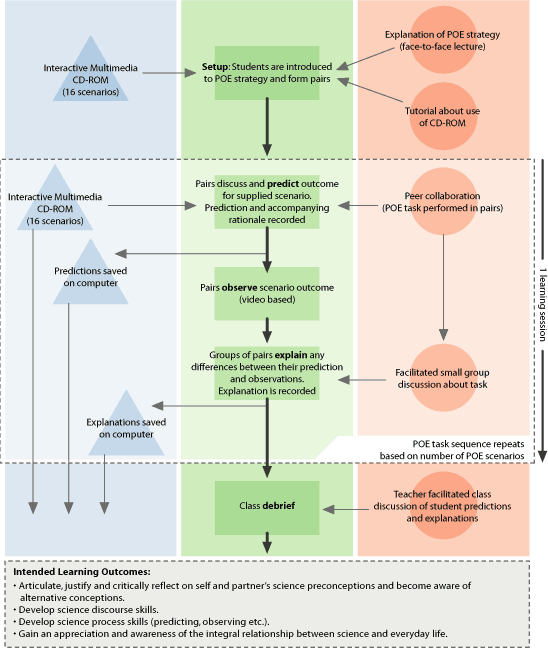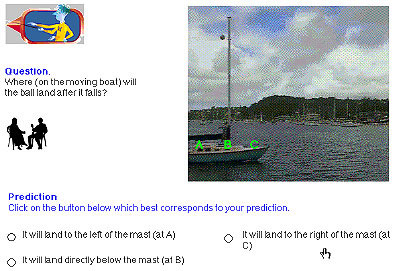 |
 |
top

| |
The learning design revolves around three main tasks: predict-observe-explain
(POE). The Learning Design Sequence is illustrated as follows.


Download PDF Version
|
top

| |
WHAT STUDENTS DO
As part of a doctoral study (Kearney, 2002) students were
required to complete 16 POE tasks in the physics domain of
vertical and projectile motion. Students select their predictions
from a range of multiple-choice options. These options are
based on alternative conceptions literature. Students then
discuss and record full-text responses for their reasons,
observations and explanations (all recorded on the computer’s
hard drive). If demonstration outcomes are too open-ended,
predictions and observations may alternatively be drawn (on
paper or electronically).
Class discussion of tasks should proceed in a session following
the students’ use of the computer-based POE tasks to
take advantage of the rich data elicited from the students’
engagement with the tasks (for example, many alternative conceptions
emerging from their recorded predictions, reasons and even
their observations).
Note: If students are inexperienced with the POE strategy,
students could just complete the prediction, reason and observation
stages of each task before conducting a whole class discussion
to facilitate student completion of the explanation stage.
Reference:
Kearney, M. (2002). Classroom Use of multimedia-supported
predict-observe-explain tasks to elicit and promote discussion
about students’ physics conceptions. Unpublished
PhD dissertation, Perth: Curtin University of Technology.
SIGNIFICANCE OF ORDER
In each POE task, it is absolutely essential that students
are committed to their prediction and reason before observing
the demonstration (White & Gunstone, 1992). The multimedia
program effectively scaffolds this sequence as students are
"forced" to discuss and record their predictions
and reasons before they are able to view the video clip. Likewise,
the program does not allow users to proceed to the final "explanation"
phase of each task until they take the time to discuss and
record their observations.
The choice of sequence of the POE tasks is also crucial as
the viewing of some demonstrations may "give away"
the correct "science view"’ for following tasks.
However, related tasks should be placed together to promote
coherence in the sequencing of the tasks.
Reference:
White, R., & Gunstone, R. (1992). Probing understanding.
London and New York: The Falmer Press.
CRITICAL ACTIVITIES
Given the relatively small scope of this learning design,
all tasks are considered critical.
|
top

| |
ACCESSIBLE RESOURCES
The CD-ROM is the main resource that students have access
to. The program has an introductory tutorial that allows students
to become familiar with the program and the QuickTime movie
tools that are crucial for making clinical observations of
the video-based demonstration outcomes (for example, the step-frame
facility is crucial in observing the change of speed of a
falling ball in Task One). The focus of the CD-ROM is the
16 POE tasks. Students only have access to the video clip
of each scenario once they have discussed and recorded their
predictions and reasons.
The first screen of each task introduces students to the
task context before asking them to proceed to the next screen,
where the problem is presented and students can make their
predictions. For complex scenarios, a brief video preview
of the scenario (without showing the demonstration outcome!)
is given after the introductory screen to help students feel
comfortable enough with the contexts to make confident predictions.

Screen shot of the "prediction"
screen for Task 12.
RESOURCES IN CONTEXT
The CD-ROM resource is significant on a number of levels:
- It allows students to engage in the POE tasks in small
groups rather than the traditional teacher-led, whole-class
environment.
- The program effectively scaffolds the students’ engagement
with the POE strategy, allowing them to proceed through
the tasks at their own pace. This includes giving students
the ability to go back and edit responses (before viewing
the outcome) and take control of the viewing of the demonstrations.
This extra autonomy gives students extra opportunities to
thoroughly discuss and reflect on their predictions, reasons
and observations.
- The computer environment facilitates the use of digital
video, allowing students to view dangerous, difficult, expensive
or time-consuming demonstrations not normally possible in
the laboratory. Usually, these are real-life, out-of-classroom
contexts and reveal interesting science phenomena that under
our normal human capabilities would go beyond our temporal,
perceptual or experiential limits. Students can use the
sophisticated tools available in the digital video medium
to make clinical and intricate observations of these scenarios
and also replay exact replicas of these demonstrations as
many times as they like. Indeed, the observation phase of
the POE strategy is crucial as it effectively provides the
feedback to users on their prediction. Hence, in terms of
the affordances of ICT for the POE strategy, the comprehensive
observations made possible by using the digital video medium
effectively enhance the quality of feedback on students’
predictions.
VARYING THE RESOURCE SET
The actual POE tasks on the CD-ROM are essential to the learning
setting. The tutorial at the start of the program could be
replaced by a whole class tutorial. Also, the students’
responses (written and drawn) that are saved as files on the
computer could be replaced by pencil and paper worksheets
if necessary.
|
top

| |
SUPPORTS SUPPLIED
It is desirable that users are familiar with the POE strategy
before using the program. The teacher facilitates small group
engagement with the tasks and peer collaboration is an essential
part of the learning design. Students’ observations of
the video-based demonstrations provide feedback on their earlier
predictions.
SIGNIFICANCE OF SUPPORT STRATEGIES
The teacher’s role is crucial in this learning setting.
Students’ queries about task contexts are essential to
address if they are to confidently make their predictions
as a first step in the POE procedure. The nature of the contexts
presented in the video-based scenarios is often complex and
the teacher’s role in clarifying these contexts and attending
to groups’ queries is essential. Students also may need
some guidance making sense of their observations and more
particularly in the challenging explanation stage where they
are asked to reconcile any differences with their predictions.
(It is possible for teachers to lead this difficult explanation
stage as a whole class discussion.)
Responses to these tasks (saved as text files on each computer)
contain a wealth of information about students’ science
conceptions. The teacher’s role in analysing this information
and identifying common alternative conceptions is a demanding
task but essential preparation for the final whole-class discussion
and indeed, in the tradition of constructivist pedagogy, a
starting point for the planning of subsequent instruction
(Driver & Scott, 1996).
Peer collaboration is also crucial in this learning setting.
Students could engage in these tasks individually but would
miss out on important opportunities to articulate, discuss
and reflect on their own and their partner’s conceptions
from different perspectives. From a social constructivist
view, students working in small groups can test the viability
of new knowledge claims with their peers, link these new ideas
with personal experience and existing knowledge and negotiate
shared understandings.
Finally, the POE strategy itself is a fundamental support
structure for this learning setting. Each task is based around
the POE strategy and structures the learner’s engagement
with the video-based demonstrations. Without it, student interaction
with the demonstrations would become passive and videos would
become subject to the "mindless clicking" syndrome.
Reference:
Driver, R., & Scott, P. (1996). Curriculum development
as research: A constructivism approach to science curriculum
development and teaching. In D.F. Treagust, R. Duit, &
B. J. Fraser (Eds.), Improving teaching and learning
in science and mathematics (pp. 94–108). New
York and London: Teachers College Press.
SUPPORT STRATEGY ADAPTATION
The POE strategy itself is critical and a fundamental support
for these learning tasks. Although detrimental to the learning
experience, it is possible for a student to engage in these
learning activities without a teacher and without a peer.
|
top
|
 |
 |
 |
 |
 |
 |
 |
 |
 |
|

